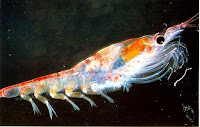Looking a lot like shrimp, these tiny crustaceans are found in enormous numbers in the world’s oceans, where they are one of the main food sources for many other marine creatures.
 Krill are tiny crustaceans (animals belonging to the group that includes shrimp and crabs). Krill are found worldwide as part of the plankton, often near the surface and especially in the polar seas.They are very abundant in the Southern Ocean around Antarctica, frequently occurring in huge numbers. Krill feed on minute floating plants called phytoplankton. In turn, krill are preyed on by whales which sieve the surface waters swallowing tens of thousands of them in one gulp—up to 4 tons in one day’s feeding! Different whale species are adapted to take krill of different sizes.
Krill are tiny crustaceans (animals belonging to the group that includes shrimp and crabs). Krill are found worldwide as part of the plankton, often near the surface and especially in the polar seas.They are very abundant in the Southern Ocean around Antarctica, frequently occurring in huge numbers. Krill feed on minute floating plants called phytoplankton. In turn, krill are preyed on by whales which sieve the surface waters swallowing tens of thousands of them in one gulp—up to 4 tons in one day’s feeding! Different whale species are adapted to take krill of different sizes. This reduces competition between them. The main krill feeders are blue, right, and fin whales, but other animals, such as seals, penguins, and seabirds, eat them as well. Commercial fisheries have been set up to catch krill but have not really been successful.
Shallow-water krill species have conspicuous eyes. In temperate and tropical waters, they respond to the amount of light in the water, rising to the surface at night when fewer predators are about. Throughout the continuous daylight of the summer at the poles they remain near the surface, however. Krill have special light producing organs along the body, which look like lines and dots. These light up under the control of the nervous system, and the bluish glow they generate is seen by other krill and helps keep them together.








0 comments:
Post a Comment